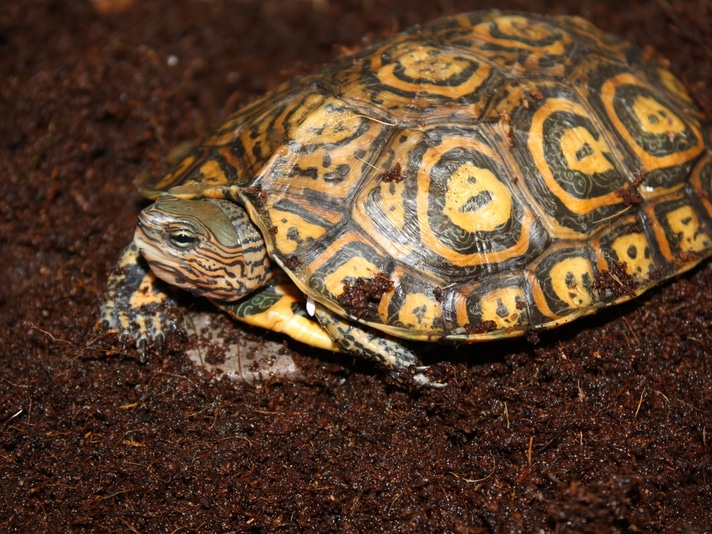Description:
Captive Housing: A low, somewhat simple enclosure, such as a glass tank measuring 48 by 24 by 16 inches tall will provide space for two adults. Smaller enclosures can be used for hatchlings up to subadults. Coconut coir and cypress mulch are both good substrates because they hold humidity well without resulting in a sopping wet enclosure. Wood turtles are semi aquatic and enjoy soaking in water for hours on end. Provide a “swimming hole” at one end of the enclosure by inserting a glass or plastic partition to create both a land area and a water area, each with a depth of about 6 inches. Turtles should be able to access both easily. A hole can be drilled into the bottom of the water section to act as a drain when cleaning. Alternatively, a wide tray measuring up to 6 inches deep can be provided as a water area and can be lifted out for easy cleaning. Again, be sure turtles can enter and exit the water area easily. Place a couple hides at the opposite end of the enclosure, even though turtles may ignore them and burrow into the substrate instead. If they hear you approaching the enclosure they will likely emerge from hiding to see what you’re up to. Place an under-tank heater beneath the land portion of the tank, and keep it on 24/7. A heat lamp can be used over the hides to create a hot spot of about 90 degrees Fahrenheit, set to a 12-hour on/off cycle. Keep a UVB lamp over the top of the enclosure, as well, also set to a 12-hour on/off cycle. To maintain humidity, use an automatic misting system, a fogger or hand sprayer. Mist the enclosure daily to maintain humidity at about 75 percent. Substrate should be damp, but not sopping wet. Diet: Wood turtles are omnivores and will eat just about anything. We feed ours greens, melons, berries and various fruits (they especially relish bananas). They also love crickets, roaches, night crawlers and pinky mice. We also feed our wood turtles Zoo Med omnivore diet (tortoise and lizard food in a can), aquatic turtle pellets (dry), iguana food, box turtle pellets and canned monitor food. Make sure that food is available every day, and alternate food items every few days so the turtles receive a nice variety. Dust all food with a quality calcium and multivitamin supplement. What’s Available: Imported Central American wood turtles—the staple source of supply for years—are still available, but in much smaller numbers. The number of captive-bred specimens that is available is greater than ever before, however, and you can often find captive-bred hatchlings, subadults and adults at pet stores, reptile shows and through online dealers. In my opinion, the Central American wood turtle is one of the smartest turtles in the world. Pets get used to handling and seem to recognize their owners, seeking them out for something neat to eat. Over time you will discover they are not shy and make very rewarding pets. This is a real winner! Extra: Although your Central American wood turtle enclosure may often look empty when the turtles are hiding, if they think you have food, they will reveal themselves, march across the enclosure to you and literally beg to be fed. They oh so love to eat.
Habitat:
Damp, humid areas, open savannas, lowland and upland rain and dry forests; never far from water
Range:
From Mexico south through central and South America to Brazil
Scientific Name: (Rhinoclemmys pulcherimma)
Species Group: turtle
Family: Geoemydidae
Size: N/A
Level: advanced
Weight: N/A
Dangerous: No



